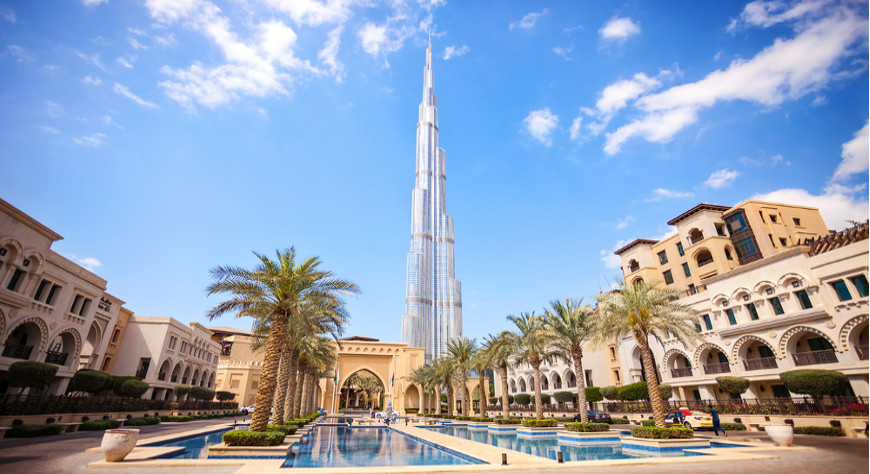It’s no secret that Dubai long ago set its sights on becoming a major global player. The city has always aimed to be talked about in the same breath as London, New York, Paris and Tokyo – and not just in the world of business and trade but fashion, food and culture as well.
It’s fair to say that the Dubai of today ranks right alongside those cities in many ways, and has very much taken its place on the world stage. So much so that Dubai is now often referred to around the globe as the “Manhattan of the Middle East”. But as fast as Dubai’s rise to the top has been, it has not happened overnight, and certainly not without a concerted effort. After all, it was a relatively small fishing village as recently as the 1960s.
There isn’t the space here to go into the focused, strategic and incredibly complex process of making Dubai what it is today. But there is room to look at one very important aspect of Dubai’s overall approach for success – and that is the art of self-promotion.
If you want to work your way into the global collective consciousness you absolutely need to be able to catch people’s eye and create a buzz. And this is a city that certainly knows a thing or two about how to do that.
Whether it’s the first, the longest, the highest – or just the most ambitious – let’s look at four major milestones that really put Dubai on the world stage as a true super city.
1.The Burj Khalifa
Aim high. That is the Burj Khalifa and that is the epitome of Dubai spirit. As the brainchild of Dubai’s ruler, Sheikh Mohammed bin Rashid Al Maktoum, the purpose of the tower was to draw attention to the city for something other than oil and to show the world that Dubai is a force to be reckoned with in terms of leisure, culture and tourism. And it certainly accomplished that.
The Burj Khalifa is the highest building in the world at over 828 metres (2,716 feet) tall. It also has the highest number of stories in the world, the highest occupied floor, the highest outdoor observation deck – you’re getting the picture. Highest. So high in fact that it is possible to watch the sunset from the tower’s base, then ride an elevator to the top and watch the sunset all over again three minutes later!
The Burj is so high that it is possible to watch the sunset from the tower’s base, then ride an elevator to the top and watch the sunset all over again three minutes later!
Inspired in the mind of American architect Adrian Smith by the beautiful structure of the regional desert flower known as the spider lily, building this global icon was – naturally – quite an undertaking. Taking over 22 million man-hours to construct, workers brought together over 330,000 cubic metres of concrete and 39,000 tonnes of steel in just 1,325 days – from start to finish.
And of course, a build of this size was not without its challenges either. An issue with funding mid-way through led to a change of name for this ambitious project – with UAE president Sheikh Khalifa bin Zayed Al Nahyan lending both his name and his money to the project formerly known as the Burj Dubai. All this is a distant memory today as the Burj Khalifa still stands proudly in the top spot – nearly 200 meters higher – than its closest rival, the Shanghai Tower.
Of course simply being home to the tallest building in the world is not enough for Dubai. As usual, the city continues to aim above and beyond to ensure its landmarks grab the world’s attention. In the case of the Burj Khalifa this could be any number of things: spectacular firework displays, world-record base jumps, and vertical fashion shows with models walking on the external facade of the tower! Or how about its long list of Hollywood credits? The Burj Khalifa has played a starring role in a number of blockbusters – including Mission Impossible-Ghost Protocol and Independence Day: Resurgence.
2. Palm Islands
Once the emirate had caught the eye of the world’s tourists, a new challenge emerged: There was only so much coastline along its shores for travellers in search of sun and sea. But in Dubai, a challenge is just an opportunity to do something extraordinary. In this case, that extraordinary feat was to build over 180km of man-made coastline that (when looking from above) is in the shape of palm trees. And so Palm Islands was born. Eventually set to consist of Palm Jumeirah, Deira Island and Palm Jebel Ali. Currently only the one we all know as Palm Jumeirah is open for business.
Perhaps the first subject to tackle here is why a palm? Well, the original palm design was apparently sketched by Dubai’s ruler himself as a rather ingenious way of maximising beachfront property – popular with tourists and residents alike. Of course sketching the palm design and then actually constructing it out of three billion cubic feet of sand – along with seven million tons of rocks per island – are two very different propositions. And to do the latter required some space-age technology. The Palm Islands’ intricate leaves – or fronds – were positioned under the guidance of a private satellite, which ensured sand placement to within 0.39 of an inch. The city of Dubai is nothing if not perfectionist!
In truth, the entire construction of the Palm Islands doesn’t get any less impressive. Over 1,200 workers, 30 excavators, 15 dumpers, 10 cranes, 4 dredgers and a team of specialist divers took on the mammoth task of collecting sand from the seabed to be shaped into the unique palm design. Even the speed at which the islands were built was impressive: 8000-ton sand dredgers were filling at a rate of one per hour and dumping at 10m/s – quick enough to fill an Olympic-sized swimming pool in just four minutes!

As well as building the islands, teams of construction workers were also tasked with building a huge breakwater to protect them from waves. And I really mean a huge breakwater – consisting of 5.5 million cubic metres of rock – enough to build two Egyptian Pyramids. (Quick sidebar here: Talking of breakwaters, how’s this for an outlandish stroke of innovation and creativity: Jebel Ali is set to feature a breakwater spelling out a line of poetry from Sheikh Mohammed bin Rashid Al Maktoum – “It takes a man of vision to write on water”.)
Without a doubt this huge undertaking was well worth it. Today, the unique palm design has become one of the iconic images of Dubai and Palm Jumeirah – which is connected internally and to the mainland by both a monorail and a sub-sea tunnel. It is now home to a vast array of malls, restaurants and hotels, while each of its 17 ‘leaves’ are lined with luxury villas.
3. The World Islands
So far we’ve had a building that dwarfs its nearest rival by 200 meters and a series of man-made islands shaped like palm trees. Can it get any more ambitious? How about a sprawling archipelago in the middle of the sea in the shape of a map of the world? In any other nation, a concept like this would forever be a fantasy, but in Dubai it became a reality.
Once again this was a project of epic proportions. Costing an eye-watering $14 billion to construct, the World Islands is made up of 321 million cubic metres of sand – that’s enough to fill around 150 Major League Baseball stadiums to the brim. Much like the Palm Islands, this ambitious project was designed to catch the eye when viewed from above. The archipelago’s 300 islands cover over 20 square miles of the Persian Gulf, range in size from 250,000 to 900,000 square feet, and are each separated by around 50 to 100 metre stretches of water.
Initial plans for The World Islands resort was to have each of its islands be bustling with both residents and tourists, though that is yet to come to fruition. While initial investments came quickly (including the island representing Great Britain being bought by Virgin CEO Richard Branson), things had slowed by 2008. However, despite rumours at the time that the ambitious project had stalled for good, today Dubai’s commitment to The World Islands looks stronger than ever.
The first island open to guests – Lebanon – is earning strong reviews while the new Heart of Europe complex looks set to capture the world’s attention all over again. The luxury resort – due to open in stages between now and 2018 – aims to create a Europe away from Europe. The site’s developer says visitors will be able to hop from island to island and experience a taste of many European countries in the middle of the Persian Gulf. In his own words, “…to allow you to have dinner in Germany, breakfast in France, and lunch in Italy.”
This being Dubai, there are no half measures. Plant life from around the world has been flown in and planted throughout the Heart of Europe to give visitors a truly authentic feel. In particular, “Spain” features ancient olive trees, cared for by a team of experts on hand to ensure they take root. Other developments are also in the works, including the “Coral Island” resort which spans over 20 islands that make up the North American part of The World, and a further complex set to comprise the 14 islands that make up Australia and New Zealand.
Plant life from around the world has been flown in and planted throughout the Heart of Europe to give visitors a truly authentic feel.
The World Islands has attracted the eyes of the world even when unfinished – as well as awe and intrigue from afar. A daily sea plane flies over the archipelago, allowing tourists to marvel at yet another breath-taking aerial shot in Dubai’s already impressive collection. Once complete, I’m willing to bet this will be the city’s most audacious and impressive accomplishment yet.
4. The Metro
Hey, sometimes purely practical also needs a mention. And let’s face it, if you want to attract people to your city in greater numbers you need to make it easy for them to get around. Once again, Dubai and its ruler Sheikh Mohammed bin Rashid Al Maktoum saw this particular challenge as yet another opportunity to make a statement – by building the longest driverless Metro in the world. Back in 2011, the Guinness Book of World Records announced its two lines totalling around 74km operating entirely without drivers was indeed a world record. And it continues to grow: In the first half of 2015, it transported over 88 million riders, and by the time Expo 2020 rolls into town, a new 15km extension on the Red Line will be in place, transporting up to 46,000 riders per hour in both directions.
As well as moving tourists and residents from A to B, the Metro, with its fully air-conditioned stations and carriages, has fast become a tourist attraction in its own right. Each of its stations is designed around one of five themes of importance to the UAE – heritage, earth, air, water, and fire. The beautiful Rashidiya station features cloud-like images and architecture, for example, and the BurJuman station is decorated to give an underwater feel. Many more stations feature design touches that you simply do not see in the subways of New York, London, Tokyo et al.
And there’s another area in which the Dubai Metro trumps many major cities’ equivalents: its punctuality. Delays are almost non-existent, and the longest travellers can expect to wait for a train anywhere is about five minutes.

As for the Metro’s actual construction – as is the case with many of Dubai’s more recent construction projects – it had the environment in mind, with all stations built to incorporate as much natural light as possible to lower energy usage. What’s more, again in what is fast becoming a staple of construction in Dubai, innovative building methods were used. Over 150 companies, employing over 30,000 people, used pioneering construction techniques such as top-down excavation methods, for example, to minimise disruption on the surface.
Ultimately, the Metro was yet another statement to the world that Dubai can more than hold its own on the global stage and cope with the demands that come from being one of the fastest growing cities in the world – all without compromising on its vision, innovation or ambition.
Building a super city
Clearly the milestones listed above had the desired effect. They caught the world’s attention and captured its imagination. However, there is much more to Dubai than grandiose gestures of ambitious engineering and design. It goes without saying that this amazing city has far more to give the world than its various record-setting achievements.
Behind all of these feats is a well-oiled machine built to market Dubai throughout the rest of the world. Indeed, the Dubai Corporation for Tourism and Commerce Marketing (DCTCM) was recently brought into force by Sheikh Mohammed bin Rashid Al Maktoum to do just that. The DCTCM works in key cities around the world to market and promote the emirate’s prowess in everything from business and trade to shopping and culture. And it is clearly working. Dubai was recently voted the best city in the world to live and work in by the alumni association of the INSEAD business school, beating out Paris and London.
Meanwhile, tourist numbers in Dubai attract envious glances from around the globe. Our city is the fourth most visited according to an annually updated report by MasterCard, with about 14 million visitors having passed through in 2015. On top of this, based on employment and GDP per capita growth, the Brookings Institution put Dubai at number four globally in terms of fastest-growing metro areas.
Dubai is the fourth most visited in the world according to an annually updated report by MasterCard.
And the best part is that Dubai is showing no signs of slowing. The government has big plans for the run up to Expo 2020 which will bring together over 180 nations and 25 million visitors. So you can rest assured that the milestones on this list won’t be the last we see on Dubai’s journey from desert to world-renowned destination.









